
The 8th Congress of the Workers' Party of Korea of the Democratic People's Republic of Korea was held in Pyongyang from 5 to 12 January 2021. This paper provides an overview of the decisions taken during the 8th Congress and analyses the directions of the country's economic, national defence and external policies, including its nuclear weapons programme.
By Katsuhisa Furukawa [1]
Introduction
The 8 th Congress of the Workers' Party of Korea (hereafter "WPK" or "the Party") of the Democratic People's Republic of Korea (DPRK) (hereafter "the Congress") was held in Pyongyang from 5 to 12 January 2021.
The Congress serves as the highest decision-making organ of the Party. This year's Congress reviewed the Party's work since the 7th Congress, which was held in May 2016, and established the directions and goals for the national policies over the next five years, including with respect to the economy, national defence, culture and management of the State and society. New leadership in the Party was also selected, and the rules and organizations of the Party were amended, in order to strengthen institutional discipline and enhance the efficiency of the Party's functions. Importantly, the Congress served as an occasion to strengthen the leadership of Kim Jong Un and the WPK and to promote public loyalty toward the Party's leadership.
The principal issue discussed during the 8th Congress related to rehabilitation of the national economy amid a series of domestic hardships and to the strengthening of national defence.
During the 2016 Congress, the WPK adopted a five-year national economic development plan based on a "strategic line of simultaneously pushing forward the economic construction and the building of nuclear force", or the byungjin policy. [2] In order to promote economic growth, the DPRK government carefully loosened State control over State-owned enterprises (SOEs) and attempted to diversify its trading partners. The Congress also determined that dramatically strengthening the DPRK's nuclear deterrence against the United States was an essential prerequisite for national economic growth.
Five years later, at the 8th Congress, Kim Jong Un, newly accorded the title General Secretary of the Party previously held by Kim Jong Il, acknowledged the failure to achieve the economic goals established in the 2016-2020 five-year plan, but emphasized that those were "deviations" in "the stage of new development" and that the problems could be solved. He proudly emphasized the "historical" achievement in successfully guiding the DPRK into becoming a nuclear-weapon State. [3]
Kim Jong Un attributed the failures on the economic front to external and internal factors. The external factors were identified as the sanctions against the DPRK, natural disasters and the global pandemic. The internal factors were identified as inadequate performance of the Party, including unrealistic goal setting and institutional problems, such as abuse of power, bureaucracy, irregularities and corruption.
At the recent Congress, the WPK established the five-year plan for 2021-2025 and the associated goals and tasks for each sector aimed at achieving "self-reliance and self-sufficiency". [4] While these decisions, overall, were similar to those made during the previous Congress, they contained some new elements, especially in the areas of foreign policy and national defence policy.
This paper provides an overview of the decisions taken during the 8 th Congress and analyses the directions of the DPRK's economic, national defence and external policies for the next five years.
Key Takeaways
The 8th Congress
-
Kim Jong Un demonstrated his leadership and his central control over the Party by reshuffling most of the key leaders and changing the structure of the WPK. Kim Yo Jong, his sister, appears to maintain her special proximity to Kim Jong Un. [5]
-
Kim Jong Un identified "socialist economic construction" as the most important task and dedicated a significant part of his 2021 report to economic affairs. [6] The national defence policy received less emphasis than it received from the 7th Congress. In addition, the number of military personnel in attendance at the recent Congress was only 8.2% of the total number of participants, a significant drop from 19.6% participation by such personnel during the 7th Congress. [7]
-
The 2021-2025 five-year plan upholds the "people-first principle" which dictates that the demands and interests of the people are to be the top priority of all industrial sectors. [8] This principle is in contrast to the "military-first politics" (Songun politics) prioritizing the Korean People's Army (KPA), which had been the guiding ideology of Kim Jong Il. However, the 2021-2025 plan also contains policies that are aimed at strengthening discipline among the people and tightening control over the influx of foreign-sourced information which could destabilize the DPRK regime.
-
The 2021-2025 plan includes a large number of ambitious goals, encompassing economy, society, national defence and governance, but the information released so far offers little in the way of practical pathways for achieving those goals. With the DPRK under considerable resource constraints, it is unclear how the plan is to be implemented.
Economic and Social Development Policy
-
The 2021-2025 plan sets forth the goal of establishing a "self-supporting economy" while reducing reliance on foreign trade and investment. To this end, the plan promotes inter-industry cooperation and import substitution, and further strengthens the State's control over the national economy, including unofficial markets. The plan appears to maintain the policy of partial deregulation of SOE activities, but makes no explicit reference to them, which indicates a possible lack of clarity about the direction of this policy.
External Policy
-
In the 2021-2025 plan, the WPK expressed confrontational postures toward the United States and its allies, but also left room for diplomatic engagement. Kim Jong Un acknowledged the importance of the 2018 DPRK-US Joint Statement at the Singapore Summit and the continuation of the legal force of the 2018 DPRK-ROK Panmunjom Declaration. However, the key figures previously involved in DPRK-US negotiations were excluded from the Political Bureau of the WPK's Central Committee. The personnel changes indicate that key individuals with experience in negotiations with the United States may be absent, at least for the time being.
National Defence Policy
-
The 2021-2025 plan establishes ambitious national defence goals pertaining to the continuous strengthening of strategic nuclear deterrence and war-fighting capabilities, including the development of new strategic and tactical nuclear weapons. The plan reflects the DPRK's evolving examination of its nuclear posture. Simultaneously, military leaders were reshuffled, with former field commanders being replaced with senior military leaders in charge of the ballistic missile programmes, indicating supremacy of the nuclear forces over the conventional forces in the country's military.
Economic and Social Development Policy
One of the key agendas for the DPRK government has been to control business activities in the unofficial (or black) markets in the country. Since Kim Jong Un became the DPRK's Supreme Leader in 2011, he has tried to incorporate unofficial markets into the framework of the national planned economy. Notably, since 2013, the DPRK government has carefully loosened State control over certain SOE activities. The SOE policy expanded the autonomy of SOE managers and increased the level of private business activities within the framework of the national planned economy, which was expected to guide the unofficial market activities into an official framework of the planned economy. The policy was implemented by instituting "the socialistic corporate responsibility management system" (SCRMS). [9]
Reportedly building on the successful outcome of SCRMS, the 2016-2020 plan established an ambitious goal of achieving 8% annual economic growth over the five-year period through technological development, trade diversification and the introduction of "a new economic management method". [10] The 2016-2020 plan also reportedly called for a break from the DPRK's exclusive reliance on trade with China, calling instead for expanded trade with Russia and other countries in Southeast Asia and the Middle East. [11]
In the end, the DPRK fell far short of achieving these objectives. [12] During the 8th Congress, Kim Jong Un decided to exclude "any external influence" over the national economy and to lower "the proportion of dependence on imports", emphasizing the goals of "self-reliance" and "self-sufficiency". [13] The 2021-2025 plan aims at enhancing national economic growth by promoting import substitution and strengthening inter-industry cooperation, while reducing national reliance on foreign investments and trade. It establishes a number of new goals for industries and other sectors, including prioritizing resource allocation to selected key sectors, especially the metal and chemical industries.
The plan also calls for strengthening State control over economic activities. Although available information suggests the continuation of SCRMS, [14] the plan makes no explicit reference to SCRMS, which indicates a possible lack of clarity about the direction of that policy. SCRMS might be expected to function as one of the means for the State to exercise control over unofficial economic activities. Kim Jong Un also ordered the WPK to tighten discipline to ensure unified State guidance on economic policy.
The new plan reiterates a number of unaccomplished goals from the previous plan, including the creation of tourism projects in the Mt Kumgang area and the establishment of a nuclear power industry, which would likely include the completion of the construction of the light water reactor in Yongbyon. [15]
External Policy
During the 2016 Congress, Kim Jong Un expressed words of caution about the United States and the ROK but refrained from explicitly articulating a hostile posture towards them. He even hinted at his intention to improve relations with the United States and its allies. [16] He requested the United States to remove sanctions and to stay away from the Korean Peninsula issue, and called for the ROK to improve DPRK-ROK relations through dialogue and negotiation at all levels in order to remove mutual misunderstanding and distrust. Kim Jong Un also requested Japan to play a positive role in achieving Korea's reunification. Notably, there was no reference to China.
To the contrary, during the 2021 Congress, Kim Jong Un declared a major departure from the country's previous diplomatic posture. He stated that the international situation surrounding the DPRK was the "harshest" since the founding of the country because of US-led sanctions. He emphasized the importance of the DPRK's relationship with China and praised the bilateral relationship with Russia, Cuba and Vietnam, which corresponds with the country's failure to diversify its trading partners due to sanctions. He denounced the United States as a "principal enemy" regardless of who might be the next US President. [17] He also repeatedly emphasized the importance of defending national dignity and prestige and his resolve to continue with its nuclear weapons programme, describing it as non-negotiable. [18] No reference was made to Japan.
Simultaneously, however, he indicated that there was also room for further negotiations with the United States and the ROK. He acknowledged the significance of the joint statement with then-US President Trump at the Singapore Summit on 12 June 2018. He positively evaluated this joint statement because it "assured the establishment of new DPRK-US relations". He also praised the DPRK-US summit meetings collectively as "an event of the greatest significance in the history of world politics". He stated that if the United States would withdraw its hostile policy and approach the DPRK with goodwill, he would also respond with goodwill, indicating the possible resumption of DPRK-US diplomatic engagement. [19]
As regards the ROK, Kim Jong Un asserted that the state of DPRK-ROK relations had returned to that which prevailed before the announcement of the 2018 Panmunjom Declaration, blaming the "hostile posture" of the ROK military and anti-DPRK demonstrations inside the ROK. He denounced the ROK for continuing its joint military exercises with the United States, as well as for the ROK's military modernization programmes, which, he asserted, ran counter to joint agreements to establish peace and stability on the Korean Peninsula. He criticized the ROK for the introduction of advanced military equipment and called for the ROK to halt all hostile acts and "faithfully implement the north-south declarations". He specified that the condition for improvement in the bilateral relationship would be to "root out any abnormal and anti-reunification conducts" in the ROK. He dismissed offers of humanitarian assistance and cooperation for epidemic prevention. [20]
Key figures previously involved in DPRK-US negotiations, including Kim Yong Chol, Ri Yong Ho and Choe Son Hui, were excluded from the Political Bureau of the WPK's Central Committee. These personnel changes indicate that key individuals with experience in negotiations with the United States may be absent, at least for the time being. On the other hand, the DPRK's Foreign Minister, Ri Son Gwon, maintained his position as an alternate member of the Political Bureau. Kim Song Nam, who has been in charge of the DPRK's policy toward China, was promoted as a member of Department Directors of the Party Central Committee. [21]
National Defence Policy
Declared Objectives
In January 2021, Kim Jong Un proudly emphasized his "historical" achievement in successfully guiding the DPRK into becoming a nuclear-weapon State and reported on the development and completion of multiple nuclear-related programmes and the possession of completely new nuclear capabilities.
Kim Jong Un stated that in order to contain the military threat from the United States, the DPRK would have to bolster its national defence capability, and that strong defence capability served as a powerful means to propel diplomacy. He concluded that "there can never be satisfaction in strengthening the military strength" and "our national defence capability must be steadily bolstered". [22]
He declared his intention to further strengthen nuclear deterrence against the United States, to continue to enhance the DPRK's capabilities for "preemptive nuclear strike" and "retaliatory strike" and to modernize the country's conventional forces in order to convert the military into a sophisticated "high-tech elite force". He stressed the importance of advancing nuclear weapons-related technologies and developing smaller, lighter nuclear weapons for tactical use. [23]
He further stated that the DPRK would not "abuse" nuclear weapons unless it was threatened by the nuclear weapons of "invasive hostile forces". [24] This statement is similar to his previous declaration during the 7th Congress of a conditional "no-first-use" policy. [25]
Nuclear Posture and Nuclear Strategy
The DPRK's nuclear posture rests on two strategies: nuclear deterrence and war-fighting, [26] as confirmed by his statements during the 8th Congress.
The DPRK has in the past prioritized the development of strategic nuclear strike capabilities against the US homeland. The DPRK's nuclear posture has evolved and now clearly envisages plans for preemptive or retaliatory use of nuclear weapons, including the use of tactical nuclear weapons against the United States and/or its allies. Kim Jong Un's statement clarified the country's intention to advance its nuclear posture beyond existential deterrence and to further develop the operational use of nuclear weapons. By introducing multiple types of nuclear weapons combined with conventional weapons, the DPRK appears to be aiming at developing the capability to control escalatory situations from low intensity to high intensity conflicts during a crisis.
According to the report by Kim Jong Un during the Congress, the DPRK's nuclear weapon capabilities have advanced in line with the following goals over the past five years: [27]
Key Goals
-
Enhancement of the precision, maneuverability and survival of nuclear strike capabilities;
-
Diversification of launch platforms for nuclear weapons;
-
Development of solid fuel ICBMs and SLBMs;
-
Research and development of associated command and control systems, including reconnaissance satellite and drones; and
-
Modernization of the defence infrastructure.
Kim Jong Un provided concrete and extensive explanations of the DPRK's nuclear programme and highlighted the country's purported achievements in the following:
Nuclear Warhead-Related Programmes
-
Development of a super-large hydrogen bomb (completed);
-
Development of miniaturized, lightened and standardized nuclear weapons for tactical use (completed); [28]
-
Research on new warheads, including "hypersonic gliding flight warheads" for new ballistic missiles, and the preparation for production of prototype warheads (completed); and
-
Research on the enhancement of warhead guidance technology and miniaturization and MIRVing [29] of nuclear warheads (its final stage was ongoing).
Missile-Related Programmes
-
Development of the ICBM Hwasong-15 (completed);
-
Development of the large ICBM displayed on an 11-axle launcher during the military parade on 10 October 2021 (completed);
-
Development of the domestic production lines for medium- and intercontinental-range ballistic missiles of the Hwasong series and the submarine-based and ground-based ballistic missiles of the Pukguksong series (completed);
-
Development of new tactical nuclear weapons including intermediate-range cruise missiles (completed);
-
Development of the new "super-large" multiple launch rocket system (MLRS) (completed); [30]
-
Modernization and remodeling of a medium-sized submarine (completed); [31]
-
Ongoing research on the design of a new nuclear-powered submarine (the final stage was ongoing).
Other Programmes
-
Development of new conventional weapons, including main tanks, [32] an anti-air rocket complex, a self-propelled gun howitzer and anti-armor weapons (completed); and
-
Research on the designs of diverse electronic weapons, unmanned striking equipment, the means of reconnaissance and detection, and military reconnaissance satellite (completed).
Most of the aforementioned programmes are no doubt intended to enhance the precision and survivability of the DPRK's nuclear strike capabilities by evading interception by the missile defence systems of the United States, the ROK and Japan, and by diversifying the means of deployment.
Additional information about these programmes is summarized in the Appendix to this brief.
Directions over the Next Five Years
Based on the above-mentioned pronouncements, the 2021-2025 five-year plans presents the following priority goals:
-
Continue to make progress on the following tasks:
Further upgrading of nuclear technology;
Miniaturization of nuclear weapons;
Further development of smaller and lighter tactical weapons, including different types of tactical nuclear weapons to be used for different combat missions; and
Production of "super-large" nuclear warheads.
-
Strengthen the nuclear preemptive and retaliatory strike capabilities by further enhancing the accuracy of missiles and increasing the range up to 15,000 km. [33]
-
Further R&D for the eventual acquisition of hypersonic glide vehicle capabilities.
-
Develop solid fuel motor for submarine-launched and ground-based ICBMs.
-
Further R&D for a nuclear-powered submarine programme and "an underwater-launch nuclear strategic weapon" to enhance nuclear long-range strike capability.
-
Secure reconnaissance and information-gathering capability based on the operation of a military reconnaissance satellite.
-
Conduct "the most important research" to develop reconnaissance drones and "other means of reconnaissance" capable of undertaking precise reconnoitering up to a 500 km depth into the adversary's front. [34]
The aforementioned programmes may have been carried out for quite some time. The country likely imported, and will continue to import, relevant technologies and material for these programmes. Eventually, the DPRK will need to test these weapon systems.
The 8th Congress confirmed the reshuffling of military leaders over the past few years, with former field commanders being replaced with senior military leaders in charge of the ballistic missile programmes, indicating supremacy of the nuclear forces over the conventional forces in the country's military. Notably, KPA Marshal Ri Pyong Chol, a former director of the Munitions Industry Department which was designated by the UN Security Council as the entity responsible for overseeing the development of the DPRK's ballistic missile programmes, [35] was promoted to Member of the Presidium of the Political Bureau of the WPK's Central Committee, Member of the Secretaries of the Party Central Committee and Vice-Chairman of the Party Central Military Commission. [36] Similarly, KPA Marshal Pak Jong Chon, the chief of the KPA's General Staff, who was responsible for commanding the firing trials of the short range ballistic missiles in March 2020, [37] was promoted to Member of the Political Bureau of the Party Central Committee and Member of the Party Central Military Commission.
Conclusion: a Difficult Road Ahead
The new five-year plan includes many ambitious goals related to the economy, national defence and governance, but it is unclear how these goals can be implemented under the significant constraints on available resources. Implementation of the entire plan would require considerable funding, technologies and materiel, which will likely continue to be unavailable to the country in the near future. What is known about the new plan is that it offers hardly any practical pathways for achieving the goals and that there are barely any indications of clear priorities among those goals. As long as the resources available to the DPRK do not substantially increase, the DPRK government and the WPK will need to decide on the priorities of each policy goal.
None of the external factors that have adversely impacted the DPRK's economic standing are likely to fade away anytime soon. Natural disasters may occur every year. The global pandemic may also continue for some time.
The declarations made during the 8th Congress suggest that the DPRK considers that, in order to accelerate diplomacy to lift sanctions, the country will have to strengthen its nuclear deterrence and war-fighting capabilities against the United States. However, if the DPRK continues to advance its nuclear capabilities, it is even less likely that sanctions will be lifted which, in turn, will make it even harder for the country to obtain the necessary resources to advance its five-year plan.
The WPK's renewed focus on the new nuclear and missile related programmes blurs the extent to which the new five-year plan departs from the previous byungjin policy. Fiscal and economic policies will continue to be affected considerably by the future course of the nuclear weapon programmes.
Similarly, the internal factors that damaged the DPRK economy may not fade away soon, especially the institutional problems of the WPK and the DPRK government, including corruption, a lack of discipline and poor management, all of which have been alluded to by Kim Jong Un himself. To fix these problems and resume economic growth, the new five-year plan focuses on the people-first principle while emphasizing the need to strengthen discipline within the Party and among the people. As the lives of people improve, their demands for information and for access to a wider variety of material goods may increase. It may become even more challenging for the DPRK government and the WPK to maintain State control over economic activities and "discipline" among the people.
Appendix: Additional Information about Military-Related Programmes
New "Super-Large" Multiple Launch Rocket System (MLRS)
The "super-large MLRS" refers to the KN-25 and possibly the unknown MLRS (see photos below).
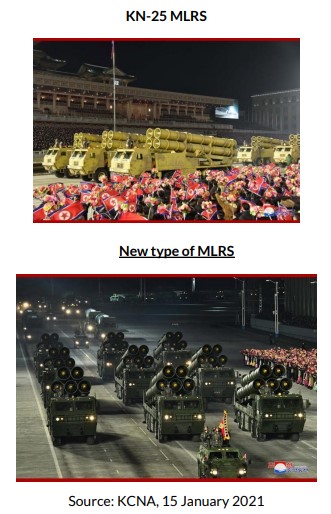
New Tactical Nuclear Weapons Including Intermediate-Range Cruise Missiles
With respect to the new tactical nuclear weapons including intermediate-range cruise missiles, the phrase most likely refers to the following missiles:
-
New missiles (possible land attack cruise missiles) displayed during the military parades on 10 October 2020 and 14 January 2020: these missiles bear a resemblance to the Russian 9M728 and 9M729 cruise missiles. The DPRK is not 14 known to have tested "intermediate-range cruise missile" [38] and would probably need to carry out a trial firing. [39]
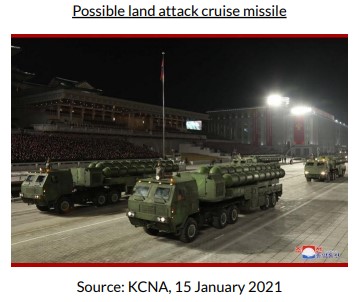
-
The solid-fuel short-range ballistic missiles (SRBMs) KN-23 and KN-24: the two SRBMs are capable of delivering both conventional and nuclear warheads. The DPRK carried out multiple trial firings of these missile systems in 2019 and 2020. According to the Japanese Ministry of Defence, the maximum flight distance of each missile was about 600 kilometers for the KN-23 and about 400 kilometers for the KN-24. [40]
-
A new solid-fuel single-stage missile that is similar to but longer than the KN-23: This missile was also displayed during the military parade on 14 January 2021 and may be capable of flying over a longer distance than the KN-23.
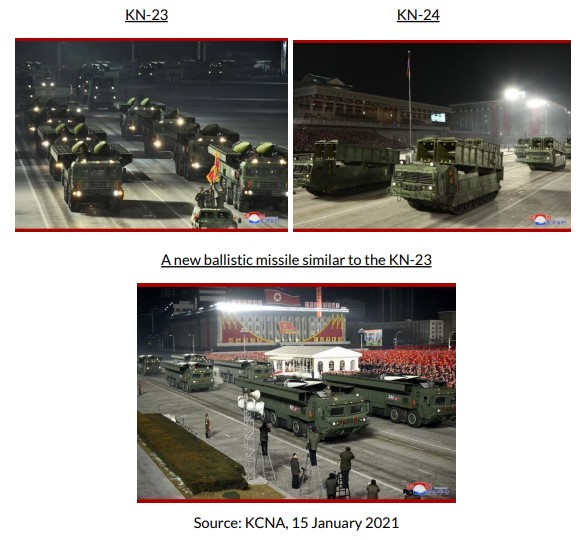
Technology and Tactics to Defeat Missile Defense System
Through a series of testing of SRBMs in 2019 and 2020, the DPRK has demonstrated its advancement in guidance technology and tactics aimed at defeating missile defence systems. [41]
In March 2020, the DPRK successfully carried out firing trials of the KN-24 once and the "super-large caliber" MLRS KN-25 three times. On each occasion, two or three projectiles were launched in a sequence and seemed to hit the same target. According to the UN Panel of Experts established pursuant to resolution 1874 (2009) (UN Panel of Experts), these firing trials are considered to have proven the reliability of the guidance system. [42] The firing intervals were also significantly reduced in comparison with 2019 firing trials, which demonstrates enhancement of the precision-strike capability and the saturation attack capability of the DPRK strategic forces.
With respect to "the hypersonic gliding flight warheads", [43] it is unclear what type of warhead may be pursued by the DPRK in this regard. Generally, hypersonic weapons refer to those flying at speeds of Mach 5 (five times the speed of sound) or above and are maneuverable during flight. Such hypersonic weapons do not follow a ballistic trajectory after the initial ballistic boost phase but travel typically in the higher atmosphere. [44] In 2018, then-US Missile Defense Agency Director Lt. Gen. Samuel Greaves noted that there was an "extremely high" risk that hypersonic strike weapon technology being developed in China and Russia could proliferate to the DPRK and Iran. [45]
Submarine-Related Programmes
The aforementioned "medium-sized submarine" most likely refers to a Chinese-type 033 (copy of Soviet Romeo-class submarine) that has undergone modification. Kim Jong Un inspected this submarine on 22 July 2019. It is not yet confirmed whether this submarine has become operational. [46] The DPRK is estimated to possess about 20 Romeo-class submarines. [47] Despite some speculation, it has not been officially confirmed that any one of them have been converted for an SLBM mission. In August 2020, the UN Panel of Experts reported that three submarines that were possibly derived from this type could be built concurrently in the Sinpo South Shipyards. [48]
The smaller Gorae-class submarine launch platform was previously used by the DPRK for a test launch of the SLBM Pukguksong-1 to address ejection and stability problems when launching the SLBM. [49]
As for the aforementioned "new nuclear-powered submarine", the DPRK is not known to have produced this type of submarine. The nuclear-powered submarine would likely need a pressurized water reactor, but it is unclear whether the DPRK is capable of producing this type of reactor for use in a submarine.
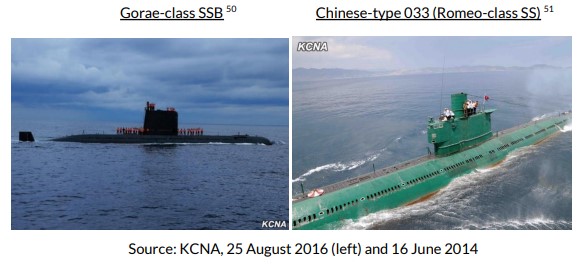
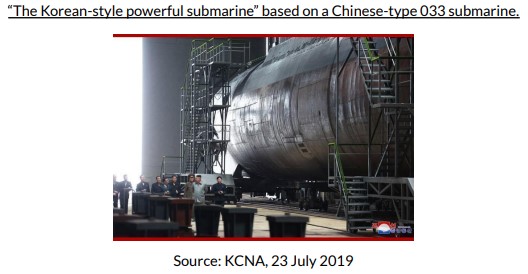
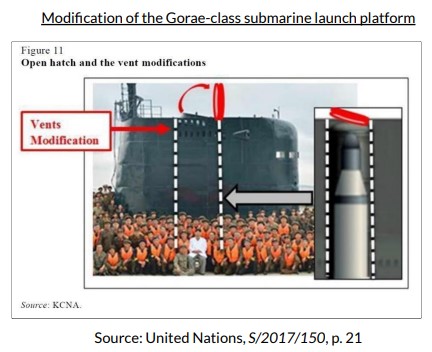
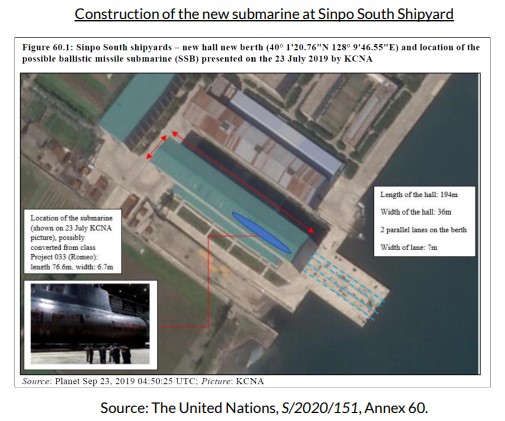
ICBM and SLBM Systems Developments
During the military parade on 14 January 2021, the DPRK displayed a new solid-fuel SLBM, Pukguksong-5, which is longer than the Pukguksong-4 SLBM that appeared during the military parade on 10 October 2020. The nose cone of the Pukguksong-5 is longer than that of the Pukguksong-4. [52]
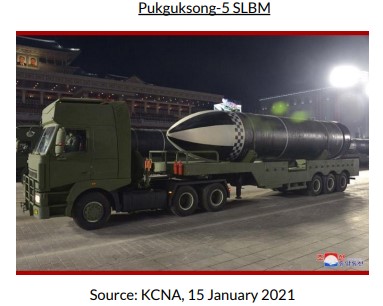
Satellite-Related Programmes
The DPRK is capable of launching a satellite, as demonstrated by the country's launch of a three-stage rocket from the Sohae Satellite Launching Station on 12 December 2012 and 7 February 2016. The DPRK claimed that the rockets successfully placed satellites into orbit, and subsequently registered them as earth observation satellites Kwangmyongsong-3-2 and Kwangmyongsong-4.
The DPRK has not launched any additional satellites since 2016. However, it has continued to upgrade Sohae Satellite Launching Station by renovating roads and pathways at and around the site in March 2020. [53] Development of the DPRK's long-range ballistic missile programme has made a significant contribution to the space rocket launch programmes, since the two vehicles share many technologies and systems.
There is no available information to confirm whether the DPRK has the capability to manufacture reliable indigenous satellites. The Kwangmyongsong-3-2 is presumed to be not functional and the operational status of the Kwangmyongsong-4 remains unconfirmed. [54]
It is unknown what type of "military reconnaissance satellite" is to be used by the DPRK. The country might need technical assistance from other countries to produce such a satellite.
Unmanned Aerial Vehicle (UAV)-Related Programmes
The DPRK displayed its largest drone to date for the first time in a military parade on 15 April 2012 in Pyongyang.
The DPRK is known to have procured UAVs (or drones) and associated spare parts, and has also attempted to procure military-grade parts.
For example, in 2013 and 2014, after wreckage from several drones were found in South Korea, ROK authorities found that the drones had flown from North Korea and captured images of the Blue House and key military facilities in South Korea. Subsequent investigation by the UN Panel of Experts found that at least some of the drones and spare parts had been procured by the DPRK in 2011 through foreign agents acting on behalf of the country. [55]
At that time, ROK authorities estimated that the DPRK possessed around 300 unmanned aerial vehicles of different types, including reconnaissance, target and combat drones. The Reconnaissance General Bureau (RGB), the DPRK's intelligence organ, was reportedly in charge of procurement, production and operation of reconnaissance drones and was also seeking to develop combat drone capabilities.
In 2012 and 2013, Czech authorities identified a DPRK diplomat (a member of the RGB) based in the Czech Republic who was seeking information about European based suppliers of spare parts for jets and reconnaissance UAVs. [56]
In 2014, a DPRK front company based in China attempted to illegally procure from the United Kingdom parts for military-grade unmanned aerial and undersea vehicles, an event that was thwarted by UK authorities. [57]
[1] With contributions by Laura Rockwood, Jaewoo Shin and Tianran Xu.
[2] By strengthening nuclear deterrence, the DPRK declared its intention to reduce the chance of a war with the United States and eventually force the United States to cease its "hostile policy" (including by the lifting of sanctions), thereby enabling the DPRK to concentrate on economic growth. See: Kim Jong Un Makes Report on Work of WPK Central Committee at Its 7th Congress, KCNA, 7 May 2016; Decision of Seventh Congress of WPK Adopted, KCNA, 8 May 2016
[3] Great Programme for Struggle Leading Korean-style Socialist Construction to Fresh Victory: On Report Made by Supreme Leader Kim Jong Un at Eighth Congress of WPK, KCNA, 9 January 2021
[4] Ibid. See also: Resolution of 8th WPK Congress Adopted, KCNA, 13 January 2021
[5] KCNA reporting suggests that the title of Kim Yo Jong, Kim Jong Un's sister, was changed from "First Vice Department Director" to "Vice Department Director", and she is not included among the members of the Political Bureau. Nevertheless, she appears to retain a special position in the WPK as she was permitted to issue a sternly worded warning to the ROK the day after the Congress. KCTV video footage also showed her walking side by side with Kim Jong Un during the Congress. As they entered the building where the Congress was held, the two seemed to enjoy a close personal conversation, which points to her continued special proximity to Kim Jong Un.
[6] The report to the Congress of Kim Jong Un was incorporated into a resolution adopted by the WPK on the final day of the Congress. Accordingly, the contents of his report are binding for the WPK.
[7] Kim Jong Un Makes Opening Address at Seventh Congress of WPK Pyongyang, KCNA, 6 May 2016; Supreme Leader Kim Jong Un Makes Opening Speech at 8th WPK Congress, KCNA, 6 January 2021
[8] During the 7th Congress, this principle was coined as "the popular masses-first principle".
[9] The 2014 amended Enterprise Act granted SOE managers, as opposed to State planners, broad rights to engage in foreign trade and joint ventures and to accept investment from domestic private investors. It also authorized them to make decisions on issues related to human resource management and production and sales of excess commodities. See: 우리 식의 경제관리방법 의 완성을 내각 관계자 인터뷰 (Completion of "Our Way of Economic Management"/ Interview with Cabinet Officials), Choson Sinbo, 10 May 2013, available at: https://www.chosonsinbo.com/2013/05/0510th-4/;「ウリ式の経済管理方法」の完成を (Need to perfect Our Way of Economic Management), Choson Sinbo, 17 May 2013, available at: https://www.chosonsinbo.com/jp/2013/05/0517th/; Mitsuhiro Mimura, Gendai Kitachousen Keizai (DPRK's Economy in the Modern Era), Tokyo: Nihon Hyoronsha, 2017 (in Japanese)
[10] According to Mainichi Newspaper, Cho Yun-yong, a South Korean researcher on the DPRK who formerly served for the ROK news agency Newsis, obtained the classified 157 page 2016-2020 plan of the five-year plan and the associated Cabinet decision, entitled "Cabinet decision No. 2" (Koichi Yonemura, Docs shed light on scope of N. Korean development strategy through 2020, Mainichi Newspaper, 20 April 2019, available at: https://mainichi.jp/english/articles/20190420/p2a/00m/0in/018000c). Subsequently, a Japanese news television programme also obtained the full text of the same five-year plan and reported on its contents, which were identical to the aforementioned reporting by the Mainichi Newspaper. See, Sunday Scoop, 独自入手!!北朝鮮「5カ年戦略」全文 行き詰まる経済 カギ握る「脱中国」[A news scoop!! A full text of the DPRK's "Five-year strategy" was obtained; An exit from the dependence on China holds the key to the economic deadlock], BS Asahi, a brief outline of the program is available at: https://www.bs-asahi.co.jp/sunday_scoop/lineup/prg_156/
[11] Ibid. According to the news article from the Mainichi Newspaper, referred to in Footnote 9, the 2016-2020 plan aimed to achieve one billion US dollars' worth of trade with Russia by 2020, and envisaged investment by Russian companies in the DPRK's special economic zones and funds for building hydroelectric plants and other facilities. The DPRK also reportedly planned to receive from Russia technological cooperation for modernizing the Kim Chaek Iron and Steel Complex and the Musan Mine in the country.
[12] Bank of Korea, Gross Domestic Product Estimates* for North Korea in 2019, 31 July 2020, available at: https://www.bok.or.kr/viewer/skin/doc.html?fn=202007300329527700.doc&rs=/webview/result /E0000634/202007
[13] Great Programme for Struggle Leading Korean-style Socialist Construction to Fresh Victory: On Report Made by Supreme Leader Kim Jong Un at Eighth Congress of WPK, Rodong Sinmun, 10 January 2021
[14] On 14 January 2021, the 4th session of the 14th Supreme People's Assembly was held in order to decide the budget to implement the five-year plan. During the session, the DPRK's economic guidance institutions were criticized for having failed to take appropriate measures and consequently hindered the development of SCRMS. This criticism indicates the government's ongoing programme to promote the SCRMS (insufficiently, though). See: 조선민주주의인민공화국 주체109(2020)년 국가예산집행의 결산과 주체110(2021)년 국가예산에 대하여--최고인민회의 제14기 제4차회의에 제기한 국가예산보고— (Report Made on Fulfillment of State Budget for Last Year and on State Budget for This Year), KCNA, 18 January 2021
[15] In his speech during the Plenary Meeting of the WPK Central Committee in late March 2013, Mr. Kim Jong Un stated: "The self-reliant nuclear power industry should be developed and the work for developing light water reactor be dynamically promoted to actively contribute to easing the strain on the electricity problem of the country." See: Report on Plenary Meeting of WPK Central Committee, KCNA, 31 March 2013, available at: http://www.kcna.co.jp/item/2013/201303/news31/20130331-24ee.html
[16] Kim Jong Un described the principle of DPRK diplomacy as improving and normalizing relations with countries that respected the sovereignty of the DPRK, irrespective of past hostile relationships. See: Kim Jong Un Makes Report on Work of WPK Central Committee at Its 7th Congress, KCNA, 7 May 2016
[17] Great Programme for Struggle Leading Korean-style Socialist Construction to Fresh Victory: On Report Made by Supreme Leader Kim Jong Un at Eighth Congress of WPK, KCNA, 9 January 2021
[18] Kim Jong Un stated that it was necessary to"[put] an end once and for all to the era in which big powers attempted to bargain with the interests of our state and nation." Ibid.
[19] Ibid.
[20] Ibid
[21] Members and alternate members of the Central Committee of the WPK, KCNA, 11 January 2021
[22] Great Programme for Struggle Leading Korean-style Socialist Construction to Fresh Victory: On Report Made by Supreme Leader Kim Jong Un at Eighth Congress of WPK, Rodong Sinmun, 10 January 2021
[23] By introducing tactical nuclear weapons, the DPRK would be able to diversify the means for striking US forces and its allies on the battlefield and/or in the theatre during a military conflict.
[24] His declaration of "no abuse" of nuclear weapons does not necessarily preclude the "first use option" if he felt threatened by the United States. This declaration is consistent with his decision to develop capabilities for a "preemptive nuclear strike".
[25] This declaration of "no-first use" was already incorporated in the DPRK's Law on Consolidating Position of Nuclear Weapons State adopted in 2013. The same law also allows for the use of nuclear weapons "to repel invasion or attack from a hostile nuclear weapons State and make retaliatory strikes," which does not exclude the possible use of nuclear weapons for preemptive purposes. It is important to note that Kim Jong Un's statement on "no-first-use" was conditional. Article 4 of the DPRK's Law on Consolidating Position of Nuclear Weapons State states: "The nuclear weapons of the DPRK can be used only by a final order of the Supreme Commander of the Korean People's Army to repel invasion or attack from a hostile nuclear weapons state and make retaliatory strikes." See: Law on Consolidating Position of Nuclear Weapons State Adopted, KCNA, 1 April 2013, available at: http://www.kcna.co.jp/item/2013/201304/news01/20130401-25ee.html
[26] During the Plenary Meeting of the WPK's Central Committee in late March 2013, then-Chairman Kim Jong Un tasked the DPRK's nuclear armed forces with the roles of "the war deterrence" and "the war strategy". See: Report on Plenary Meeting of WPK Central Committee, KCNA, 31 March 2013, available at: http://www.kcna.co.jp/item/2013/201303/news31/20130331-24ee.html
[27] Great Programme for Struggle Leading Korean-style Socialist Construction to Fresh Victory: On Report Made by Supreme Leader Kim Jong Un at Eighth Congress of WPK, Rodong Sinmun, 10 January 2021
[28] The "hydrogen bomb" refers to the nuclear weapon tested in Punggye-ri, the DPRK, on 3 September 2017.
[29] A multiple independent reentry vehicle allows multiple nuclear warheads to be aimed at different targets.
[30] Presented during the military parade in Pyongyang on 10 October 2020.
[31] The Chinese version of the KCNA news article refers to this submarine as "the heavy submarine".
[32] A new prototype tank was displayed during the military parades in Pyongyang on 10 October 2020 and on 14 January 2021.
[33] The rationale for 15,000 km is unclear. All US territories fall within the range of 13,000 km from Pyongyang. Nevertheless, this new goal is indicative of the DPRK's intention to continue to improve its ICBM strike capability.
[34] Almost all of the ROK is within 500 km from Pyongyang.
[35] The United Nations Security Council 1718 Committee, The List established and maintained pursuant to Security Council resolution 1718 (2006), p. 18, available at: https://scsanctions.un.org/fop/fop?xml=htdocs/resources/xml/en/consolidated.xml&xslt=htdocs/r esources/xsl/en/dprk.xsl
[36] Press Release of First Plenary Meeting of 8th Central Committee of WPK Issued, KCNA, 11 January 2021
[37] Supreme Leader Kim Jong Un Guides Firepower Strike Drill of Long-range Artillery Sub-units of KPA on Front, KCNA, 3 March 2020
[38] The DPRK launched a surface-to-ship cruise missile on 14 April 2020. The ROK Ministry of Defence assessed that this cruise missile was of the same type as those launched by the DPRK on 8 June 2017.
[39] Open Nuclear Network, Viewbook of DPRK 10 October 2020 Parade, ONN, 10 October 2020, p. 19, available at: https://opennuclear.org/publication/viewbook-dprk-10-october-2020-parade
[40] The Japanese Ministry of Defence, 北朝鮮による核・弾道ミサイル開発について [The Developments of the DPRK's Nuclear and Ballistic Missile Programmes], October 2020, available at: https://www.mod.go.jp/j/approach/surround/pdf/dprk_bm.pdf
[41] According to the information from the UN Panel, when the DPRK launched the KN-23 and KN-24 from 4 May to 28 November 2019, the KN-23 was launched eight times with two types of trajectory; depressed and depressed with pull-up (the pull-up is performed to extend the range). The KN-24 was also launched four times with two types of trajectory, depressed and depressed with pull-up. Nevertheless, these missiles are considered to be ballistic missiles by the United States and its allies because these missiles used a propulsion system only during the boost phase, with a majority of their flight being unpowered, unlike the cruise missile. See: the United Nations, S/2020/151, annex 59
[42] The United Nations, S/2020/840, annex 7
[43] Hypersonic speeds are typically speeds that are at least five times greater than the speed of sound, or Mach 5. See: Susan Davis, Hypersonic Weapons - A Technological Challenge for Allied Nations and NATO?, a draft General Report for the Science and Technology Committee, NATO Parliamentary Assembly, 18 June 2020, available at: https://www.nato-pa.int/download-file?filename=sites/default/files/2020-07/039%20STC%2020 %20E%20-%20HYPERSONIC%20WEAPONS.pdf
[44] Dean Wilkening, Hypersonic Weapons and Strategic Stability, Survival, vol. 61 no. 5, October-November 2019
[45] Sherman, Jason, MDA Director: "Extremely high" risk that North Korea, Iran obtain hypersonic missile tech, Inside Defense, 11 April 2018
[46] Supreme Leader Kim Jong Un Inspects Newly Built Submarine, KCNA, 23 July 2019
[47] The Japanese Ministry of Defence, 2020 Defense of Japan, Part I, Chapter 2, Section 3-1-2), available at: https://www.mod.go.jp/j/publication/wp/wp2020/html/n12301000.html#a21
[48] The United Nations, S/2020/151, Annex 60
[49] The United Nations, S/2017/150, p. 21
[50] Kim Jong Un Guides Strategic Submarine Underwater Ballistic Missile Test-fire, KCNA, 25 August 2021
[51] Kim Jong Un Inspects KPA Naval Unit 167, KCNA, 16 June 2014
[52] Xu Tianran, Highlights of the DPRK Military Parade on 14 January 2021, Datayo / ONN, 18 January 2021, available at: https://opennuclear.org/publication/highlights-dprk-military-parade-14-january-2021-0
[53] The United Nations, S/2020/840, Annex 30
[54] The Kwangmyongsong-3-2 satellite reportedly lost stabilization after orbit insertion. See: Eric Talmadge, Crippled NKorean Probe could Orbit for Years, AP, 18 December 2012, available at: https://web.archive.org/web/20131029210856/http://bigstory.ap.org/article/crippled-nkorean-p robe-could-orbit-years?goback=.gde_3433693_member_197139555; The Kwangmyongsong-4 satellite reportedly met the same issue but it appeared to have regained control. See: Andrea Shalal, David Brunnstrom, North Korea satellite in stable orbit but notseen transmitting: U.S.sources, Reuters, 9 February 2016, available at: https://www.cbsnews.com/news/north-korea-satellite-tumbling-in-orbit-u-s-officials-say/; In an interview with AP, a DPRK official claimed that the Kwangmyongsong-4 "transmitted 700 photographic images back to Earth within one day after its launch" and that the satellite was "still working properly and sending data" whenever it passed over the DPRK. See: Eric Talmadge, AP Exclusive: North Korea hopesto plant flag on the moon, AP, 4 August 2016, available at: https://apnews.com/article/88fa76909dec40b299658a34b489dc1a#:~:text=In%20an%20intervi ew%20with%20The,within%20the%20next%2010%20years; In May 2017, the DPRK state television published what it claimed to be satellite images of the THAAD missile defense systems deployed in the ROK, without specifying the source of the images. See: N. Korea unveils'satellite photos' of THAAD in S. Korea, Yonhap News Agency, 10 May 2017, available at: https://m-en.yna.co.kr/view/AEN20170510009000315
[55] The United Nations, S/2015/131, paras. 61-68 and S/2016/157, paras. 78-86
[56] The United Nations, S/2020/840, paras. 74-77
[57] The United Nations, S/2016/157, paras. 87-91